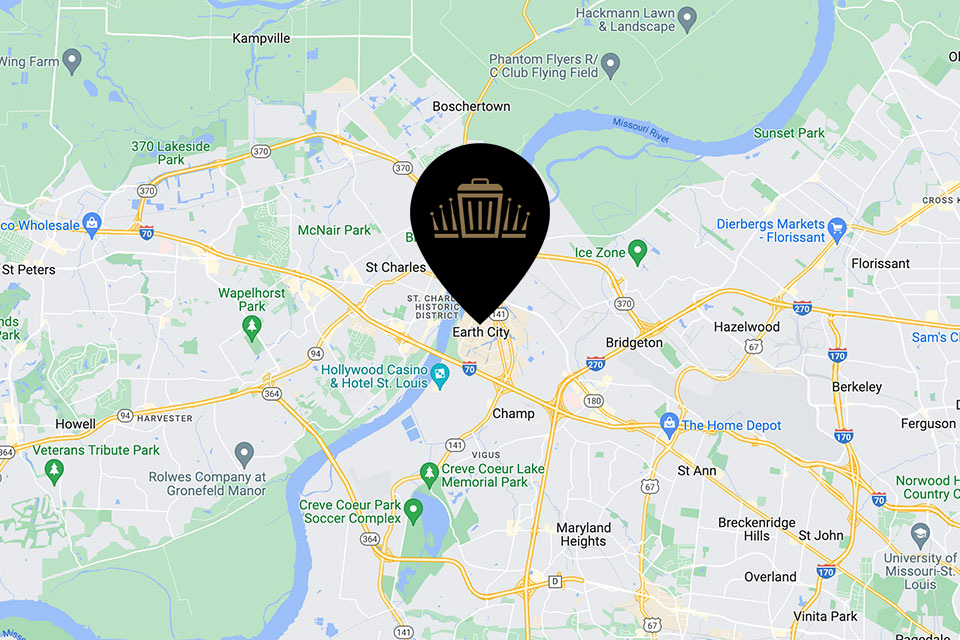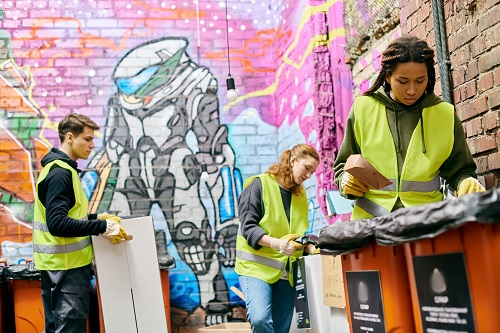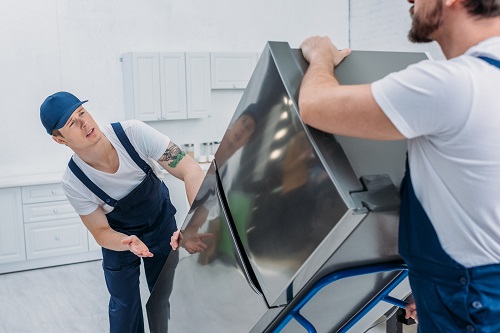Restaurant Cleanout Services
Restaurant cleanouts involve clearing out expired ingredients, worn-out appliances and leftover trash from kitchens and dining spaces to maintain a sanitary and organized environment.Teams go through and help sort, pack and haul out stuff — fridges, tables and broken gear. Most adhere to health code to prevent infestation and mildew.Clear spaces help new owners start fresh or let staff get down to business with repairs. To remain open and meet safety codes, many restaurants have cleanouts every year or before major renovations.
GET A FREE ESTIMATE
What will it cost for us to remove your junk and take it to a disposal site? We would love to provide you with an approximation of the final price. All you have to do is give us some information about the cleanout or demolition project you have in mind. Please fill out the nearby form.
The Core Reasons
Restaurant cleanouts are key to maintaining a safe, efficient, and appealing establishment. Comprehensive cleaning on a consistent basis supports not just food safety but waste reduction, staff well-being, and branding. Cleanouts count for each piece of the business, from the kitchen to the dining room, and establish the baseline for customer confidence and employee pride.

Health and Safety
Compliance with health regulations is about more than just surface cleaning. It’s the deep clean outs that locate and eliminate hidden perils, such as expired food, out-of-date kitchen devices, and food build-up. These practices reduce the likelihood of food poisoning from bacteria like salmonella, E. Coli, or listeria.
Health inspectors love this kind of cleanliness. The kind of food and cooking demands customized cleaning. For instance, meats-centric menus need special attention to prevent cross-contamination. Kitchen tools, broken tools, and clutter must be cleared out to ensure everyone has a safer workspace.
Floors require attention all day; they can’t be cleaned just at closing because of slips and cleanliness.
Read More
Eliminating unused gear smooths workflow. With kitchen tools and appliances within easy reach, staff spend less time searching for items and more time making food. Free-flowing dining rooms and storage spaces free your staff and customers to maneuver without obstructions, reducing accidents and increasing productivity. The core reasons are that they’re not so much heading in a really well-planned layout post-cleanout, so you work faster. This helps prevent day-to-day habits from leaving grease or food residue behind in out-of-sight places. Eliminating unused or broken equipment cuts repairs and reduces consumption. Cleanouts help highlight any items that can be resold, further contributing to your revenue. Enhanced inventory control through discarding expired stock and organizing storage reduces waste and perhaps creates space for new menu offerings. Sorting and recycling during cleanouts reduces disposal fees too. Garbage fees can add up quickly. Clean spaces drive profitability by increasing customer happiness. A neat, well ordered restaurant says to the customers ‘we care about your experience.’ Fresh, clutter-free tables bring in new visitors and ensure that old hands stay loyal. Customers see a hygiene slip, even a tiny one, and it can be bad for business. There’s nothing like a cleanout to refresh your decor and ambiance while maintaining your space’s appeal. Getting ahead of food safety and cleanliness demonstrates integrity and develops trust. Employee morale soars when the workplace is tidy and safe. Involving staff in cleanouts gives them a voice and helps spot issues others may miss. Clearing broken furniture and worn out equipment reduces the potential for injury. When tools work, staff can get on with their job, not repair it. This strategy minimizes stress and fosters productivity. A restaurant cleanout blueprint provides a detailed guide for decluttering, eliminating obsolete equipment, and organizing optimized zones. Planning minimizes downtime, and kitchens run best with little downtime. Staff input and strategic scheduling are essential to success, particularly in bustling urban and suburban communities. By outlining every step, restaurant teams can meet cleanouts head-on, even when curveballs arise. Start with a walk-through. Scope everything from dry storage to prep stations. Identify where junk accumulates or things are left unutilized. These locations might be corners behind heavy appliances, shelving units, or forgotten closets. Next, conduct an inventory check. Inventory all tools and materials. See if they work great or have safety concerns. A busted mixer or outdated cleaning chemicals, for instance, need to go. Scan your health and safety regulations for immediate hazards, such as obstructed exits or hazardous food storage. Solicit employee feedback. Their insight helps identify everyday sore spots, like an infrequently used fryer taking up space, that executives might overlook. Make a plan before you clean out. Set a timeline: plan at least 4 to 6 weeks ahead to allow for detailed prep. Give everyone a role, so every task has an owner. Take a prioritized approach. Dry storage can be wiped down first, then third level prep stations, then cooking lines. This sequence maintains kitchen momentum as long as possible. Make a checklist for each area. Write out steps, like tossing expired food, unplugging and relocating old fridges, and deep cleaning shelves. It assists in monitoring progress and maintaining rigor. When it’s time for equipment removal, schedule slow days or overnight hours to minimize disruption. Leverage off-peak hours, such as seasonal slowdowns, to reduce prices and prevent employee burnout. Hire junk removers for your bulky stuff. These crews do the heavy lifting and disposal. For commercial kitchen equipment, ensure power and gas lines are safely shut off. Take apart machines so they can fit through doorways and not be damaged. During the day, check off your progress toward your checklist. If things lag, tweak the schedule or bring in additional assistance. Keep in close touch with employees. Daily updates keep everyone in the loop and prevent craziness. Post-cleanout, look over all spaces. Ensure all clutter is eliminated. Get staff feedback on what worked and what didn’t. This input is necessary for future cleanouts. Let’s get those kitchen tools and supplies organized for optimal workflow. Store frequently used items at arm’s reach. Start a maintenance plan: schedule regular checks and use seasonal rotations to keep clutter from building up again. New equipment is energy efficient. Replacing old machinery with new can significantly reduce monthly bills, so cleanouts are an investment move. Smart restaurant cleanouts are about more than just chucking stuff in the bin. Thoughtfulness about your waste makes you look professional, supports sustainability, and leaves guests with a great lasting impression. Clear, tidy areas assist in preparing the way for unforgettable dining experiences and a seamless flow of service, especially during rush hours. Junk removal is about more than just how it looks; it’s a respect for your customers and it reflects your community values of minimizing waste and being resourceful. Step one is sorting out the cardboard, plastics, and metals to be recycled. Many kitchen supplies, containers, and packaging can be recycled with the right systems. Working with local recyclers ensures these materials are processed in line with local regulations, minimizing landfill impact and bolstering community sustainability efforts. Employees need to understand what matters goes where and why, which can be accomplished with periodic education or signage on bins. Keeping track of recycling volumes each month provides a tangible measure of progress and something to communicate about to keep everyone accountable and engaged. Functional kitchenware, from ovens to forks, have a new life with various charitable organizations, shelters, or soup kitchens. See what organizations near you receive food-safe or working items. Scheduling cleanout pickups with donation centers leads to less hassle and less waste. Get staff involved; it builds a common mission, especially if they can vote on what goes where. Staff recommendations are a great way to tease out some of those hidden gems that would otherwise get missed. Local food banks Homeless shelters Educational cooking programs Nonprofit thrift stores Old tables, chairs, or shelves don’t have to end up in a landfill. With a little ingenuity, they can be re-purposed into host stands, decorations, or even artwork. Collaborating with local artists or makers creates new destinations for old junk. Bringing these stories back to customers, either on social media or in person, shows the community a peek of what’s possible with a little vision. When driven by the staff, these upcycling projects can be a source of innovation and help further brand the restaurant. Get more people brainstorming and you’ll get real, unexpected solutions. The recycling bins minimize waste, save you money, and express eco-conscious care for the planet. Less landfill waste Lower disposal costs Better public image More support from eco-minded customers Restaurant cleanouts provide a combination of technical and practical challenges that extend beyond just cleaning. The requirement to maintain rigorous hygiene standards, handle biohazards, and minimize downtime in cleanouts complicates the process beyond other environments. Kitchens and storage rooms specifically require special attention because of increased hazards from chemicals, equipment, and food residue. These specialized challenges imply that the owners and managers have to strategize in order to avoid making expensive errors. There are sharp objects in restaurants, particularly in kitchens. Old refrigerants, solvents, and potent cleaning chemicals can be health and safety hazards if not dealt with properly. Some antique sprinkler systems or refrigerators might involve prohibited substances or require professional removal. Local regulations frequently mandate these materials to be safely stored, labeled, and disposed of. Not following these rules can result in fines, lawsuits, or injury to employees and patrons. Staff training is crucial. Employees need to identify and safely manage hazardous substances. This isn’t just about being healthy; it’s about compliance. For instance, ammonia-based cleaners or used oil filters require specialized disposal and if you mishandle them, they’re environmental pollutants. Good training includes how to utilize protective gear and where to safely place hazardous items prior to collection. Most restaurants tag these items and store them in locked cupboards. Hazardous Material Common Source Handling Requirement Refrigerants (CFCs, HCFCs) Old freezers, coolers Certified removal, no venting Ammonia-based cleaners Kitchen cleaning Gloves, sealed disposal bags Used oil/grease Fryers, grills Store in sealed drums Solvents, degreasers Maintenance closets Store away from food Mercury bulbs Lighting fixtures Recycle as hazardous waste Commercial kitchen appliances can weigh hundreds of pounds. Taking it out without inspecting the building’s structure can make floors crack or walls shift. Before any big move, a complete check-up is required. By this, I mean seeking out the cracks behind heavy-duty ranges or walk-in freezers. If you encounter red flags such as sagging floors or cracked tiles, pause and call in a structural engineer. They can recommend bracing or repairs that should be done prior to the equipment’s outage. It’s clever to be recording these findings. By way of specialized challenges, use notes, photos, and diagrams to maintain a record for insurance or future upgrades. This step shields you from surprises if new equipment is introduced later. Safety will always be the first priority, as will making sure that we keep the restaurant open and safe for our team and guests. It’s never easy moving big, clunky equipment out of a restaurant. Narrow doors, tight hallways, and busy work areas make it even more of a challenge. Usually, it has to be done off-hours to not interfere with service. Scheduling can be hard, particularly if maintenance crews are understaffed or if the restaurant is bustling all day. Sometimes, it is only accessible through windows or by ripping down equipment in place. You’ll need a concrete plan for each. In other words, charting the path for big pieces, staging the location, and ensuring all required equipment and personnel are on hand. Communication is important as well. Staff should know when and where work will occur, so they can steer clear or anticipate delays. Using an expert cleanout crew, versed in these environments, can save time and reduce errors. They show up with the appropriate tools and expertise to finish the work efficiently and safely. Restaurant cleanouts fall into two main types: planned and emergency. Each requires its own methods to ensure the room remains secure, efficient, and accessible. Planned cleanouts are scheduled events that keep spots tidy, equipment in service longer, and costs down. Emergency cleanouts come quick, typically due to unexpected malfunctions, leaks, or health hazards. Being good at responding to both types keeps the kitchen humming and sidesteps additional fees. Understanding the distinction allows owners, managers, and staff to make smarter decisions, reduce downtime, and comply with health coding. Planned, not Emergency Routine cleanouts, scheduled on a weekly or monthly basis, maintain spaces open and ensure gear is operating optimally. This prevents problems from accumulating and results in expensive repairs or even health code violations. For instance, numerous restaurants reserve one morning per week for a comprehensive kitchen sweep, inspecting storage, refrigeration, and food preparation spaces. These inspections detect leaks, mold, or damaged equipment before they worsen. Staff are a key part of catching clutter early. By being reticent to come in when problems arise, small spills or broken equipment won’t be overlooked. Easy systems: Some restaurants have straightforward checklists for employees to cover at the end of each shift, while others incorporate cleanout items into staff meetings. This way everyone is on the same page and engaged in maintaining the safety of the location. Routine planning aligns with regulatory guidelines that usually have inspections at scheduled intervals to maintain certifications and prevent penalties. Planned cleanouts aid your energy savings. When machines are clean and inspected, they use less energy, which reduces bills and increases efficiency. In the long run, companies experience fewer disastrous days and more reasonable, error-free workdays. Reactive response is the way a team handles immediate messes or failures. They can occur during rush hours, from a spill, broken fridge, or health hazard. To manage them, restaurants require a transparent response strategy. This involves understanding who should be called, what should be done, and having junk removal professionals on hand. Staff need to know how to handle emergencies quickly, without losing their head or screwing up. Short training sessions, posted instructions, and simple steps assist new and experienced staff. Having open lines with junk removal or repair people means help is swift. Other locations maintain a contact list near the phone or in a communal online document. Postmortems after an emergency are a time for teams to discuss what transpired and what was effective or ineffective. This assists you in constructing improved plans for the next time. Over time, these reviews reduce risk, save dollars, and get everyone prepared for whatever comes. Emergency cleanouts are more expensive, up to 30% higher than planned work, due to lost time and additional repairs and stress. Planning ahead keeps these surprises infrequent and less damaging. A restaurant cleanout is not only about scrubbing the floors and tossing out expired products. It provides the psychological reset for the entire team. There’s something about the physical act of ordering something—whether it’s stacking napkins or wiping down a counter—that has a bigger impact than most of us realize. Research, such as this paper from the Journal of Applied Psychology, finds that this attention to minutiae makes you happier at work and perform better. When staff routinely clean up behind themselves, such as arranging chairs or brushing up crumbs, it only takes seconds and helps establish a culture of pride and respect throughout the entire team. By inspiring all of you to approach the cleanout as a psychological reset, we take the focus off of tasks and place it on renewal. Employees might feel more bonded to the area, knowing they contribute to maintaining it in form. This is an opportunity to push all of us in the direction of prosocial behaviors, acts that assist others, such as clearing off a table or assisting a colleague. These habits are related to characteristics such as conscientiousness and emotional intelligence. Conscientious employees utilize checklists not to be rigid, but to free their brains for larger matters, like chatting with visitors or fixing issues. By cleaning up, they have found a means to cultivate self-discipline that makes the work flow more smoothly and helps employees demonstrate respect for customers and co-workers. A hygiene ethos doesn’t merely whitewash things. It boosts spirit. When they see their workmates care about the space, it’s easier to take pride in your own work. These small resets, such as setting a phone face down and taking a minute to scan the room to see what needs attention, help keep everyone present and mindful. These points in time allow employees to demonstrate respect for one another’s time and efforts, strengthening the bond of the team collectively. As psychologists have observed, individuals who pick up after themselves tend to be more conscious of their impact on others, a mentality that engenders trust within the collective. A cleanout is a clever time to establish new goals. Teams can leverage this space to discuss what’s working and what needs to shift. Perhaps the kitchen requires a new system for identifying leftovers, or the dining hall could benefit from an improved way of transporting and storing supplies. Owning the mess based on the principle that if you make a mess, you clean it up instills in all of us ownership. It’s an attitude that makes the restaurant hum and keeps the team pushing forward together. Restaurant cleanouts require talent, speed, and incisors. Grease traps, coolers, and storage bins contain waste and hazards. Tools such as wet vacs, steam cleaners, and heavy bags do a lot of work. Teams have to learn food codes and health laws. Every measure, from waste to restaurant cleanouts to mopping floors, protects food. Employees need to handle items with caution and be on the lookout for potential hazards such as mold or leaks. Cleanout is not trash; staff clean out old stock, deep clean equipment, and check for pests. With every restaurant cleanout comes an opportunity to rewrite the rules and establish new habits. To maintain safe kitchens, schedule cleanouts, train crews, and utilize appropriate equipment. For more tips or assistance, connect with a pro or attend a workshop.Operational Flow
. Financial Gains
. Brand Image
. Staff Well-being
The Cleanout Blueprint
Assessment
Strategy
Execution
Post-Cleanout
Beyond The Bin
Recycling
Donating
Upcycling
Why It Matters
Specialized Challenges
Hazardous Materials
Structural Integrity
Logistical Hurdles
Planned vs. Emergency
Proactive Planning
Reactive Response
The Psychological Reset
Conclusion
Restaurant Cleanout Services
Let the JUNKWISELY team take the stress out of your restaurant cleanout . We are dedicated to delivering not just a service, but a solution, allowing you to focus on what’s next. Experience the ease and satisfaction of a professionally handled cleanout by choosing JUNKWISELY.

UPFRONT PRICING
We don’t beat around the bush when it comes to junk removal prices. At the beginning of your appointment, we’ll be able to calculate the final cost of our services. That way, you’ll be able to know what you’ll owe us from the start. Why wait until later?

PROFESSIONAL SERVICE
You’ll be glad that you chose JUNKWISELY because our crew delivers a truly professional image. It’s because of our clean uniforms, smiling faces, and good work ethic that we’ve been able to meet the needs of so many clients before you.

ATTENTION TO DETAIL
Not only will we Remove your appliance with ease, but we’ll also sweep up behind ourselves so that you don’t have to deal with whatever mess was hiding beneath it. We’ll do whatever it takes to ensure your complete satisfaction because you deserve it! .
SAVE $20 WHEN YOU
BOOK ONLINE
No need to delay your appointment. Schedule with us online, and you can save twenty dollars.

READY TO SERVE YOU
Whether you need us to get rid of a refrigerator, freezer, washing machine, or dryer, we’re ready to get to work. All you have to do is book an appointment. Use either of the buttons below to get in touch with us. We’re looking forward to meeting you!




